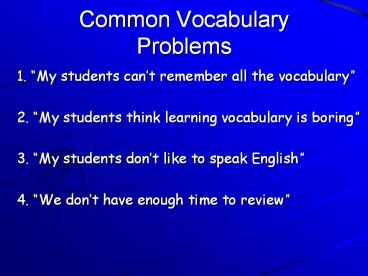Common Vocabulary Problems - PowerPoint PPT Presentation
Title:
Common Vocabulary Problems
Description:
Research shows: 80% of what we forget. is lost 24 hours after learning! ... 1. T asks whole class questions about the picture. 2. Students answer. Traditional method ... – PowerPoint PPT presentation
Number of Views:44
Avg rating:3.0/5.0
Title: Common Vocabulary Problems
1
Common Vocabulary Problems
- 1. My students cant remember all the
vocabulary - 2. My students think learning vocabulary is
boring - 3. My students dont like to speak English
- 4. We dont have enough time to review
2
1. My students cant remember all the words.
3
Forgetting curve - short term memory
4
LEARNING FACT
Research shows 80 of what we forget is lost
24 hours after learning!
5
Why do students forget vocabulary?
- Students don't understand the word(s) fully.
- Students don't get enough time to use practice
the vocabulary. - Students don't record store the vocabulary well.
6
Research on vocabulary
- Past research suggested that it took
- or more meetings with a word before students
are likely to remember a word.
hear
say
see
write
7
Research on vocabulary
Recent research suggests it takes 20-50
meetings!
hear
say
see
write
8
Review Techniques
- How does GFI help Ss to remember vocabulary?
- Page to page
- Lesson A gt Lesson B
- Self-check
- Unit to unit
- Review units
- Word list
Vocabulary is recycled in GFI
9
Vocabulary and Pictures
A ______ is worth a thousand words.
A picture is worth a thousand words.
10
GFI Units introduce new vocabulary with bright,
colourful pictures to uncover new vocabulary in a
motivating way!
11
Presenting Vocabulary
Exercise 1a introduces 6-8 vocabulary items.
1. Meaning 2. Recognize spelling ( read )
pronunciation ( listen ) 3. Produce spelling (
write ) pronunciation ( speak ) 4. Use in
sentences
hear
speak
read
write
12
Using pictures
Traditional method
- 1. T asks whole class questions about the
picture. - 2. Students answer
13
Using pictures
Communicative method
- 1. T writes Qs. on board.
- 2. Ss open books
- discuss in pairs.
- 3. T chooses individual
- Ss to answer questions.
14
Teaching Tips for Pictures
- Using pictures in a CLT way
- allows for
- Schema Activation
- Personalization
- Eliciting of vocabulary - (Ask Qs.)
- Brainstorming of vocabulary
- Prediction
- Discussion pairs/groups
- Pre-teaching of vocabulary
- - (Vocabulary match-ups)
- Creating interest in the topic!
15
Teaching Tips for Pictures
- 1. Where are they?
- 2. What is the womans job?
- 3. Who is the man?
- 4. What is the man doing?
- 5. Do you often eat in restaurants like this?
- 6. What kind of food do you like to order?
Allowing students choice increases chances of
success.
16
Teaching Tips for Pictures
Where? What? Why? Do? How often? Who?
17
Possible solutions
- 1. Word lists
- 2. Mind maps
- 3. Labelled pictures
- 4. Personal
- vocabulary books
- 5. Flash cards
18
1. Word Lists
19
A) Self-test/check
- (?) I know.
- (?) I dont know.
20
B) Test your partner
- How do you sayin English?
- How do you sayin Chinese?
- Teaching Tip
- Ideal for warm-up activity
- Mime for verbs and some nouns
- Pictionary - Draw pictures
- Monitor students
21
Whole class
Write down the English / Chinese for
- Individually
- Team competitions
22
C) Review the list at the beginning /
end of class
- As a class
- In pairs
- Silently
23
D) Use as a Learning Resource
- Use the list when doing
- exercises and activities
24
E) Find the words
Students find the words in each unit and circle
them.
25
2. Mind Maps
26
Word Lists Book 3, Unit 8.
- drive
- shark
- future
- off
ate pool outdoor else
- win
- gift
- got
- visitor
end happy
27
Mind maps
Comedy
Classical
Pop
Jazz
Action
Love
Comics
Magazines
Football
Swimming
Newspapers
Badminton
28
- Why is it easier to remember
- words in mind maps
- compared to lists?
or
29
Advantages of Mind maps
- Word relationships
- Personalization
- Both sides of the brain
30
(No Transcript)
31
2. Mind Maps
Personality
Height
outgoing
quiet
tall
short
funny
serious
Describing People
Body
Hair
thin
fat
long
short
light
heavy
straight
curly
Book 3, Unit 6.
32
Mind mapping
- Put them on the classroom wall
- Put them where they can see it every day
33
Mind map - Sample
34
Mind maps - Tips
- Try to make your mind map simple easy to
understand avoid having too many groups - Use different colours for different groups
- Use opposites
- Use pictures
- Use collocations ( e.g. verb noun )
- Use sub-groups
35
Common teacher concern
- I like the idea of mindmaps, but they take a
long time to create. Also some students take a
long time to make them, while others finish quite
quickly. The ones who finish early have nothing
to do while theyre waiting for the others to
finish.
Possible solution Mind maps are ideal for
homework. Students can work in their own time and
spend as much or as little time on them as they
wish. Make sure you check their work and motivate
them by awarding them points for creative /
effective mindmap!
36
3. Labelled pictures
Label your pictures
37
4. Personal Vocabulary Books
38
Teaching Tip - Personal Vocabulary Books
- Categorise words into
- Specific Topic
- Word Forms
- Alphabetically
- Course Book Units
39
Definitions examples
40
5. Flash cards
Double sided































